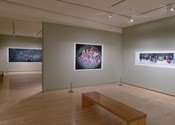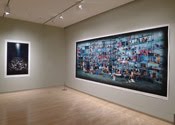 JTF (just the facts): A total of 12 large scale color photographs, unframed and pinned directly to green/grey walls in a series of rooms on the lower level of the museum. The works on view were made between 1997 and 2005; overall dimensions and edition sizes were not available. The exhibit also includes 3 video terminals showing various works and footage from the staging of certain images, as well as a glass case containing 7 books. The show was curated by Christopher Phillips. Since photography is not allowed in the ICP galleries, the installation shots for this show at right come via the Artnet article linked below.
JTF (just the facts): A total of 12 large scale color photographs, unframed and pinned directly to green/grey walls in a series of rooms on the lower level of the museum. The works on view were made between 1997 and 2005; overall dimensions and edition sizes were not available. The exhibit also includes 3 video terminals showing various works and footage from the staging of certain images, as well as a glass case containing 7 books. The show was curated by Christopher Phillips. Since photography is not allowed in the ICP galleries, the installation shots for this show at right come via the Artnet article linked below.
Comments/Context: Over the past decade, Wang Qingsong has solidified his place among the top echelon of Chinese contemporary photographers. A representative sample of his recent work is now on display at the ICP, and should finally introduce him to a much broader slice of the New York art world.
Wang’s earliest works satirize the cultural clash between traditional Chinese culture and the influx of Western consumerism by juxtaposing old and new with kitchy excess. A well-known poster from the Cultural Revolution celebrating the power of the ink brush has been updated with books on exam shortcuts. A multi-armed Buddha now holds a cellphone, cigarettes, and beer, perched on a Coca-Cola pedestal. And a 10th century scroll has been reimagined with bored peasant women in tarted-up eye makeup and Jack Daniels bottles strewn across the tables. This strange hybrid culture mixes past and present, where the ideals of the past have been polluted by the onslaught of brands and commerce. Once the jolt of Wang’s humor wears off, the effect is surprisingly sad and empty.
His more recent pictures amplify these ideas into monumental scenes with elaborate sets and hundreds of actors, following in the footsteps of Crewdson and Wall, but with a more caustic and cynical point of view. Hundreds of old-style paper political posters now feature hand-drawn Western logos: McDonald’s, Citibank, Evian, and Pampers. An English language class now caters to the needs of the nouveau–riche, with handy phrases appropriate for the Olympics or the Venice Biennale. Several of the works chronicle the plight of the migrant workers who have left the countryside and flooded the coastal cities: a massive dormitory made of blue scaffolding, where tenants sit nude often echoing art history favorites, squatter families living in a demolished building, and mobs of injured workers trying to get through a burning checkpoint made of barbed wire and soda cans. The critique is harsh and skeptical, each picture full of numerous smaller dramas and references that support the larger thematic construct.
Overall, Wang’s vision of modern Chinese society is a parody of meaning and refinement, where crude and vulgar have replaced cultured and thoughtful, exposing both the crass and unseemly side of the new materialism and its unfortunate downstream effects. His exaggerations and cinematic narratives are powerful and ultimately quite deflating, describing a world (both West and East) that seems headed down the path toward the increasingly inane, unfulfilled, and expressionless.
 Collector’s POV: Wang’s photographs have become consistently available in the secondary markets in recent years. Prices have generally ranged between $6000 and $100000, with a few extremely large tableaux selling for as much as $700000.
Collector’s POV: Wang’s photographs have become consistently available in the secondary markets in recent years. Prices have generally ranged between $6000 and $100000, with a few extremely large tableaux selling for as much as $700000.
My favorite image in the show was Follow Me, 2003; it’s the large image on the left in the top installation shot. I like the ridiculous scale of the huge chalkboard and the way English language phrases like “I’d like to make a deposit” or “I’m just hanging out with my friends doing a little bargain hunting” are combined into a dense all-over composition. It’s a little like a treasure hunt, with tiny ironies and barbs hiding everywhere.
Rating: ** (two stars) VERY GOOD (rating system described here)
Transit Hub:
Wang Qingsong: When Worlds Collide
Through May 8th
International Center of Photography
1133 Avenue of the Americas
New York, NY 10036





By the way, for those of you that have seen these prints up close, I wanted to know what people thought of the pervasive areas of blurriness in a handful of images. This is especially evident in Dormitory, where much of the upper half of the image is out of focus. This is so evident/distracting that it can't have been an accident or overlooked by the artist. Is this just a function of extremely large sets that can't be brought into focus at all depths, or some other artistic reason? I've been wondering about this since I saw the show, and am hoping someone else can fill in the gaps in my understanding.